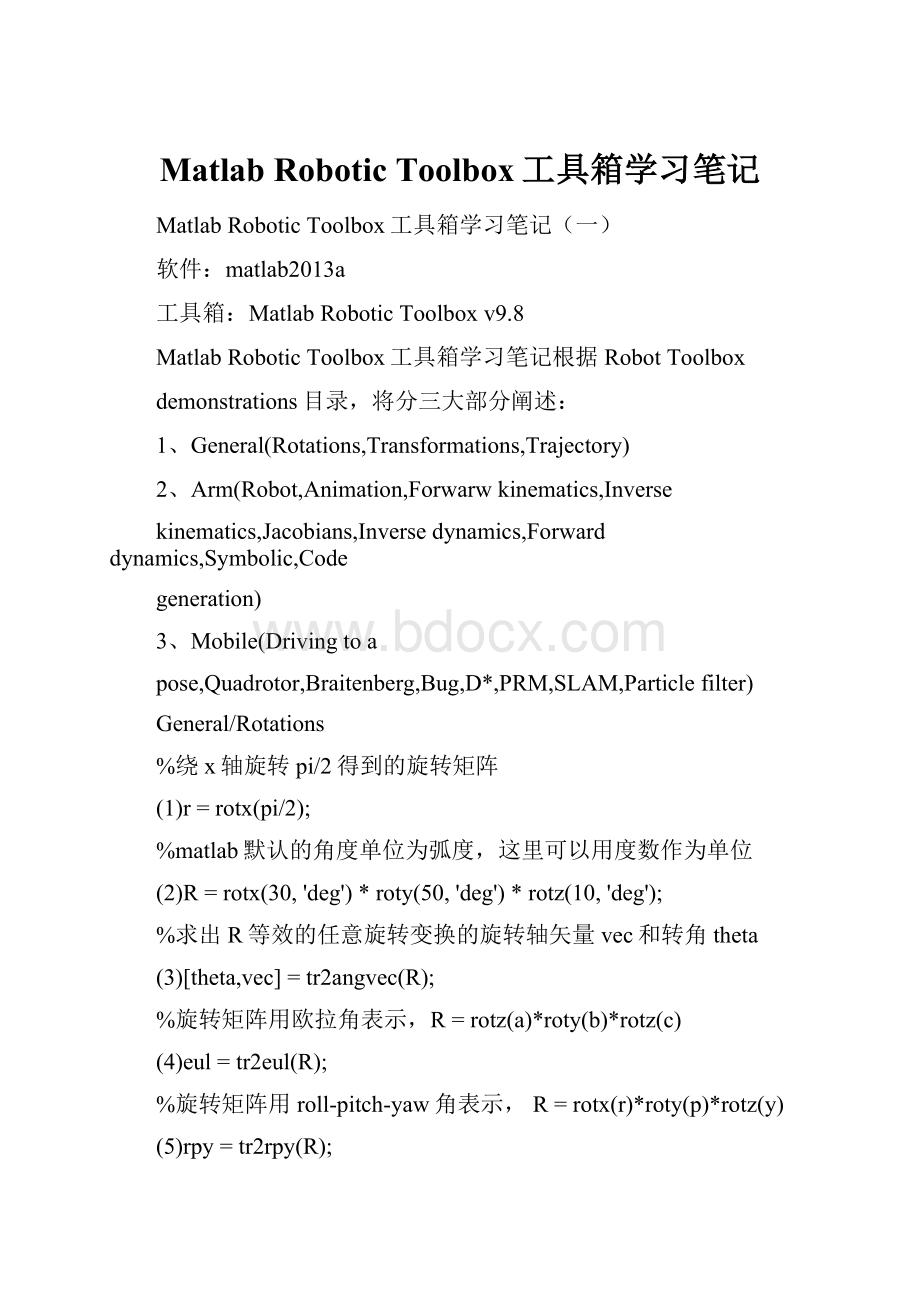Matlab Robotic Toolbox工具箱学习笔记.docx
《Matlab Robotic Toolbox工具箱学习笔记.docx》由会员分享,可在线阅读,更多相关《Matlab Robotic Toolbox工具箱学习笔记.docx(16页珍藏版)》请在冰豆网上搜索。

MatlabRoboticToolbox工具箱学习笔记
MatlabRoboticToolbox工具箱学习笔记
(一)
软件:
matlab2013a
工具箱:
MatlabRoboticToolboxv9.8
MatlabRoboticToolbox工具箱学习笔记根据RobotToolbox
demonstrations目录,将分三大部分阐述:
1、General(Rotations,Transformations,Trajectory)
2、Arm(Robot,Animation,Forwarwkinematics,Inverse
kinematics,Jacobians,Inversedynamics,Forwarddynamics,Symbolic,Code
generation)
3、Mobile(Drivingtoa
pose,Quadrotor,Braitenberg,Bug,D*,PRM,SLAM,Particlefilter)
General/Rotations
%绕x轴旋转pi/2得到的旋转矩阵
(1)r=rotx(pi/2);
%matlab默认的角度单位为弧度,这里可以用度数作为单位
(2)R=rotx(30,'deg')*roty(50,'deg')*rotz(10,'deg');
%求出R等效的任意旋转变换的旋转轴矢量vec和转角theta
(3)[theta,vec]=tr2angvec(R);
%旋转矩阵用欧拉角表示,R=rotz(a)*roty(b)*rotz(c)
(4)eul=tr2eul(R);
%旋转矩阵用roll-pitch-yaw角表示,R=rotx(r)*roty(p)*rotz(y)
(5)rpy=tr2rpy(R);
%旋转矩阵用四元数表示
)(q=Quaternion(R);6
%将四元数转化为旋转矩阵
(7)q.R;
界面,可以是“rpy”,“eluer”角度单位为度。
%
(8)tripleangle('rpy');
General/Transformations
%沿x轴平移0.5,绕y轴旋转pi/2,绕z轴旋转-pi/2
(1)t=transl(0.5,0.0,0.0)*troty(pi/2)*trotz(-pi/2)
%将齐次变换矩阵转化为欧拉角
(2)tr2eul(t)
%将齐次变换矩阵转化为roll、pitch、yaw角
(3)tr2rpy(t)
General/Trajectory
clear;
clc;
p0=-1;%定义初始点及终点位置
p1=2;
p=tpoly(p0,p1,50);%取步长为50
figure
(1);
plot(p);%绘图,可以看到在初始点及终点的一、二阶导均为零
[p,pd,pdd]=tpoly(p0,p1,50);%得到位置、速度、加速度
%p为五阶多项式,速度、加速度均在一定范围内
figure
(2);
subplot(3,1,1);plot(p);xlabel('Time');ylabel('p');
subplot(3,1,2);plot(pd);xlabel('Time');ylabel('pd');
subplot(3,1,3);plot(pdd);xlabel('Time');ylabel('pdd');
%另外一种方法:
[p,pd,pdd]=lspb(p0,p1,50);
figure(3);
subplot(3,1,1);plot(p);xlabel('Time');ylabel('p');
subplot(3,1,2);plot(pd);xlabel('Time');ylabel('pd');%可以看到速度是呈梯形
subplot(3,1,3);plot(pdd);xlabel('Time');ylabel('pdd');
%三维的情况:
p=mtraj(@tpoly,[012],[210],50);
figure(4);
plot(p)
%对于齐次变换矩阵的情况
T0=transl(0.4,0.2,0)*trotx(pi);%定义初始点和目标点的位姿
T1=transl(-0.4,-0.2,0.3)*troty(pi/2)*trotz(-pi/2);
T=ctraj(T0,T1,50);
first=T(:
:
1);%初始位姿矩阵
tenth=T(:
:
10);%第十个位姿矩阵
figure(5);
tranimate(T);%动画演示坐标系自初始点运动到目标点的过程
MatlabRoboticToolbox工具箱学习笔记
(二)
Arm/Robots
机器人是由多个连杆连接而成的,机器人关节分为旋转关节和移动关节。
创建机器人的两个最重要的函数是:
Link和SerialLink。
1、Link类
一个Link包含了机器人的运动学参数、动力学参数、刚体惯性矩参数、电机和传动参数。
操作函数:
%A连杆变换矩阵
%RP关节类型:
'R'或'P'
%friction摩擦力
%nofriction摩擦力忽略
%dyn显示动力学参数
%islimit测试关节是否超出软限制
%isrevolute测试是否为旋转关节
%isprismatic测试是否为移动关节
%display连杆参数以表格形式显示
%char转为字符串
运动学参数:
%theta关节角度
%d连杆偏移量
%a连杆长度
%alpha连杆扭角
%sigma旋转关节为0,移动关节为1
%mdh标准的D&H为0,否则为1
%offset关节变量偏移量
%qlim关节变量范围[minmax]
动力学参数:
%m连杆质量
%r连杆相对于坐标系的质心位置3x1
%I连杆的惯性矩阵(关于连杆重心)3x3
%B粘性摩擦力(对于电机)1x1或2x1
%Tc库仑摩擦力1x1或2x1
电机和传动参数:
%G齿轮传动比
%Jm电机惯性矩(对于电机)
2、SerialLink类
操作函数:
%plot以图形形式显示机器人
%teach驱动机器人
%isspherical测试机器人是否有球腕关节
%islimit测试机器人是否抵达关节极限
%fkine前向运动学求解
%ikine6s6旋转轴球腕关节机器人的逆向运动学求解
%ikine33旋转轴机器人的逆向运动学求解
%ikine采用迭代方法的逆向运动学求解
%jacob0在世界坐标系描述的雅克比矩阵
%jacobn在工具坐标系描述的雅克比矩阵
%maniplty可操纵性度
%jtraj关节空间轨迹
%accel关节加速度
%coriolis关节柯氏力
%dyn显示连杆的动力学属性
%fdyn关节运动
%friction摩擦力
%gravload关节重力
%inertia关节惯性矩阵
%nofriction设置摩擦力为0
%rne关节的力/力矩
%payload在末端坐标系增加负载
%perturb随机扰动连杆的动力学参数
属性:
%links连杆向量(1xN)
%gravity重力的方向[gxgygz]
%base机器人基座的位姿(4x4)
%tool机器人的工具变换矩阵[T6totooltip](4x4)
%qlim关节范围[qminqmax](Nx2)
%offset偏置(Nx1)
%name机器人名字(在图形中显示)
%manuf注释,制造商名
%comment注释,总评
%plotoptoptionsforplot()method(cellarray)
%n关节数
%config机器人结构字符串,例如'RRRRRR'
%mdh运动学中约定的布尔数(0=DH,1=MDH)
怎样创建一个机器人?
%Link调用格式:
%{
(1)L=Link()创建一个带默认参数的连杆
(2)L=Link(L1)复制连杆L1
(3)L=Link(OPTIONS)创建一个指定运动学、动力学参数的连杆
OPTIONS可以是:
%'theta',THjointangle,ifnotspecifiedjointisrevolute
%'d',Djointextension,ifnotspecifiedjointisprismatic
%'a',Ajointoffset(default0)
%'alpha',Ajointtwist(default0)
%'standard'definedusingstandardD&Hparameters(default).
%'modified'definedusingmodifiedD&Hparameters.
%'offset',Ojointvariableoffset(default0)
%'qlim',Ljointlimit(default[])
%'I',Ilinkinertiamatrix(3x1,6x1or3x3)
%'r',Rlinkcentreofgravity(3x1)
%'m',Mlinkmass(1x1)
%'G',Gmotorgearratio(default0)
%'B',Bjointfriction,motorreferenced(default0)
%'Jm',Jmotorinertia,motorreferenced(default0)
%'Tc',TCoulombfriction,motorreferenced(1x1or2x1),(default[00])
%'revolute'forarevolutejoint(default)
%'prismatic'foraprismaticjoint'p'
%'standard'forstandardD&Hparameters(default).
%'modified'formodifiedD&Hparameters.
%'sym'considerallparametervaluesassymbolicnotnumeric
注:
不能同时指定“theta”和“d”
连杆的惯性矩阵(3x3)是对称矩阵,可以写成3x3矩阵,也可以是[IxxIyyIzzIxyIyz
Ixz]
所有摩擦均针对电机而不是负载
齿轮传动比只用于传递电机的摩擦力和惯性矩给连杆坐标系。
%}
%SerialLink调用格式:
%{
(1)R=SerialLink(LINKS,OPTIONS),OPTIONS可以是:
'name'、'comment'、'manufacturer'
'base'、'tool'、'gravity'、'plotopt'
(2)R=SerialLink(DH,OPTIONS),矩阵DH的构成:
每个关节一行,每一行为[thetad
aalpha]
(默认为旋转关节),第五列(sigma)为可选列,sigma=0(默认)为旋转关节,sigma=1为移动关节
R=SerialLink(OPTIONS))没有连杆的机器人3(
(4)R=SerialLink([R1R2...],OPTIONS)机器人连接,将R2的基座连接到R1的末端.
(5)R=SerialLink(R1,options)复制机器人R1
%}
L1=Link('d',0,'a',1,'alpha',pi/2);%定义连杆1,没有写theta说明theta为关节变量
L1.a;%查看a的值
L1.d;%查看d的值
%还可以L1.RP,L1.display,L1.mdh,L1.isprismatic,L1.isrevolute等等,这样就可以查看一些默认值
L2=Link('d',0,'a',1,'alpha',0);
bot=SerialLink([L1L2],'name','myrobot');
bot.n;%查看连杆数目
bot.fkine([0.10.2]);%前向运动学
bot.plot([0.10.2]);%绘制机器人
定义完连杆和机器人便可以求机器人前和逆向运动学、动力学等等。
L1.参数或属性():
查看连杆的参数或属性
L1.操作函数(参数):
操作连杆参数
bot.属性():
查看机器人的属性
bot.操作函数(参数):
操作机器人,可以进行前向、逆向运动学求解等
实例:
StanfordManipulator
D-H参数表:
clear;
clc;
L1=Link('d',0,'a',0,'alpha',-pi/2);%定义连杆
L2=Link('d',1,'a',0,'alpha',pi/2);
L3=Link('theta',0,'a',0,'alpha',0);
L4=Link('d',0,'a',0,'alpha',-pi/2);
L5=Link('d',0,'a',0,'alpha',pi/2);
L6=Link('d',1,'a',0,'alpha',0);
bot=SerialLink([L1L2L3L4L5L6]);%连接连杆
bot.display();%显示D-H参数表
forward_kinematics=bot.fkine([-0.20.1100.112])%前向运动学
求出末端的齐次变换矩阵:
clear;
clc;
L1=Link('d',0,'a',0,'alpha',-pi/2,'sym');%定义连杆
L2=Link('d','d2','a',0,'alpha',pi/2,'sym');
L3=Link('theta',0,'a',0,'alpha',0,'sym');
L4=Link('d',0,'a',0,'alpha',-pi/2,'sym');
L5=Link('d',0,'a',0,'alpha',pi/2,'sym');
L6=Link('d','d6','a',0,'alpha',0,'sym');
bot=SerialLink([L1L2L3L4L5L6]);%连接连杆
symstheta1theta2d3theta4theta5theta6;
forward_kinematics=bot.fkine([theta1theta2d3theta4theta5theta6])%前向运动学
Stanfordarm的运动学逆解:
clear;
clc;
clearL
%thdaalpha
L
(1)=Link([000-pi/20]);%定义连杆
L
(2)=Link([010pi/20]);
L(3)=Link([00001]);
L(4)=Link([000-pi/20]);
L(5)=Link([000pi/20]);
L(6)=Link([01000]);
bot=SerialLink(L,'name','Stanfordarm');%连接连杆
T=transl(1,2,3)*trotz(60,'deg')*troty(30,'deg')*trotz(90,'deg')
inverse_kinematics=bot.ikine(T,'pinv');%逆向运动学
theta1=inverse_kinematics
(1);
theta2=inverse_kinematics
(2);
d3=inverse_kinematics(3);
theta4=inverse_kinematics(4);
theta5=inverse_kinematics(5);
theta6=inverse_kinematics(6);
forward_kinematics=bot.fkine([theta1theta2d3theta4theta5theta6])%前向运动学,验证结果的准确性.
%求解结果为T与forward_kinematics一致。
正确。
求解Stanfordarm在世界坐标系描述的雅克比矩阵
clear;
clc;
clearL
%thdaalpha
L
(1)=Link([000-pi/20]);%定义连杆
L
(2)=Link([010pi/20]);
L(3)=Link([00001]);
L(4)=Link([000-pi/20]);
L(5)=Link([000pi/20]);
L(6)=Link([01000]);
bot=SerialLink(L,'name','Stanfordarm');%连接连杆
symstheta1theta2d3theta4theta5theta6;
J0=vpa(bot.jacob0([theta1theta2d3theta4theta5theta6]),4)
求平面二自由度机器人在世界坐标系描述的雅克比矩阵
D-H参数表:
clear;
clc;
clearL
L
(1)=Link('d',0,'a','a1','alpha',0,'sym');%定义连杆
L
(2)=Link('d',0,'a','a2','alpha',0,'sym');
bot=SerialLink(L,'name','Planar2-dofrobot');%连接连杆
symstheta1theta2;
J0=bot.jacob0([theta1theta2]);
J0=simplify(J0)
求得:
J0=
[-a2*sin(theta1+theta2)-a1*sin(theta1),-a2*sin(theta1+theta2)]
[a2*cos(theta1+theta2)+a1*cos(theta1),a2*cos(theta1+theta2)]
[0,0]
[0,0]
[0,0]
[1,1]